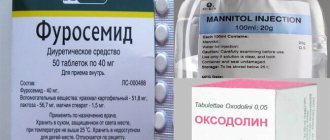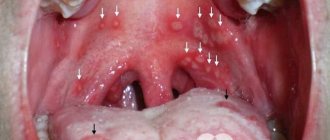One of the most common diseases in the autumn and spring periods is inflammation of the larynx or, in other words, laryngitis.
A pathological process characterized by inflammation of the mucous membranes, the treatment of which must be carried out in a timely manner to avoid undesirable consequences. Laryngitis can occur due to both infectious and non-infectious causes.
Non-infectious can be:
- regular smoking;
- overstrain of the vocal cords;
- contaminated air;
- hypothermia;
- frequent drinking;
- inhalation of certain chemical gases that irritate the mucous membranes.
Non-infectious include the following:
- viral infection (influenza, rhinovirus, adenovirus, parainfluenza, metapneumovirus, etc.);
- bacterial infection (hemophilus influenzae, pneumococcus, bordetella).
Currently, a distinction is made between chronic laryngitis and acute laryngitis, and the first type of laryngitis is most often caused by constant exposure to non-infectious causes or a consequence of acute laryngitis, the treatment of which was carried out without due attention.
Symptoms and main causes of sore throat
The most common causes of sore throat are bacterial and viral infections, allergies, polluted air, dry air and tobacco smoke (including second-hand smoke).
Viruses caused by colds attack mucous tissues directly in the throat, with the development of an allergic reaction, inflammation and soreness occur due to swelling of the mucous membrane and more mucus.
Inflammation resulting from a bacterial infection is always characterized by a severe course, accompanied by severe sore throat, difficulty swallowing and fever. Most often, inflammation is caused by a viral infection:
- cold,
- vocal cord infection,
- mononucleosis (a viral infection that causes a long-lasting sore throat),
- other viral infections such as mumps or flu.
Bacterial infections that cause pain:
- inflammation or infection of the tonsils (tonsillitis),
- inflammation of the epiglottis (epiglottitis),
- in rare cases, the problem may be caused by gonorrhea or chlamydia.
Other causes of inflammation of the throat and larynx include injuries and irritations that last longer than a week:
- irritation in the throat due to low humidity, air pollution, shouting or dry nasal cavity,
- mouth breathing, especially during allergies or nasal congestion,
- heartburn,
- damage to the back of the throat.
Symptoms of inflammation in the throat and larynx include:
- burning in the throat
- sore throat radiating to the ears,
- difficult and painful swallowing,
- sore throat and foreign body sensation,
- hoarseness and pain when speaking,
- enlarged local lymph nodes,
- increased secretion from the throat mucosa,
- heat.
Diagnostics
In most cases, to identify an illness in an adult, it is enough for a doctor to conduct an examination, as well as find out all the symptoms that have appeared in the patient and listen to all complaints in order to prescribe the correct treatment.
Laryngoscopy (a method of examining the larynx through the oral cavity using an endoscope or laryngoscope) is rarely used and only in the most difficult cases.
In children, it is important to distinguish inflammation of the larynx, which is most often accompanied by false croup, from diphtheria, which is true croup. The instrumental examination is also based on laryngoscopy, which helps to identify edema, hyperemia, increased vascular pattern or petechial hemorrhages in the laryngeal mucosa, as well as thickening and insufficient closure of the vocal folds during phonation.
Treatment of inflammation in the throat and larynx with traditional remedies
Recommended medications for inflammation are designed to stabilize the immune system, help heal inflamed tissue in the throat, and relieve pain. Unless otherwise indicated in the recommendations for use, these drugs should be taken as long as symptoms of inflammation persist. They can also be combined with over-the-counter medications and prescribed antibiotics.
- vitamin C,
- garlic,
- echinacea,
- zinc lozenges,
- goldenseal tincture,
- liquorice.
Vitamin C helps fight upper respiratory tract infections that cause sore throat. It is a natural antihistamine and can therefore reduce the production of inflammatory antibodies in allergy sufferers.
Garlic and echinacea have antiviral and antibacterial properties. They should be taken at the first sign of irritation in the throat.
If the sore throat is caused by a cold, try zinc lozenges - they help relieve soreness and, according to scientific research, can shorten the duration of the disease.
An alternative to zinc is marshmallow root. This natural remedy coats the mucosa to facilitate swallowing and relieve pain, and also contains oligomeric proanthocyanidin complexes that suppress infections and allergic reactions.
To support the immune system, add a few drops of goldenseal tincture to your tea - it is especially effective against bacterial infections due to the anti-inflammatory component berberine.
For swelling of the mucous membranes, add licorice (dried root or tincture) to tea, however, do not take it if you have high blood pressure.
Gargling a sore throat with sage
Sage is a plant with antiseptic effects. 2 tsp. dried sage pour ¼ liter. boiling water and leave to brew for 20 minutes under the lid. Drain and add 1 tsp. baking soda or salt. Use the solution as a rinse, repeat 3 times a day.
Cabbage throat compress
Place large cabbage leaves in boiling water for a short time, then wrap them around your neck and secure with a scarf. Keep the compress for half an hour. After an hour, repeat the treatment.
Wonderful ginger against sore throat
In case of problems with inflammation and burning in the throat, this root is almost irreplaceable. It is enough to grate a small piece of fresh ginger into each dish or add ¼ tsp. dried.
It is also good to drink ginger tea. It’s easy to prepare: pour about 1 cm of rhizome with ½ liter. boiling water, leave for 20 minutes, add honey and lemon.
Ginger has antibacterial effects, helps with swelling of the mucous membranes and promotes blood circulation in them, which supports the body in the fight against inflammation.
Potato compress
Boil 3 potatoes, place them on a cotton cloth and mash them. Wrap the compress around your neck, secure with a warm scarf and leave overnight.
Curd compress
Mash the cottage cheese with a fork and place on a clean cloth. Apply the compress to your throat and secure with a bandage. Leave it overnight. The next morning, the symptoms of inflammation - soreness and sore throat - will significantly decrease.
Lard and nutmeg to help sore throat and larynx
Another compress that is used in folk medicine for inflammatory processes in the throat and larynx is lard (or rather, lard). Lubricate a thin cloth or cotton diaper with it. Sprinkle with chopped nutmeg. Wrap your neck and secure the compress with a warm scarf. In the morning you will notice relief.
Sour cabbage
This healthy food has nothing to do with relieving inflammation and soreness, but cabbage is rich in vitamin C, hence it is a good helper in increasing the body's defenses.
Honey is the savior of a sore throat and larynx
This product has antimicrobial properties that relieve sore throats, reduce inflammation and speed up the healing of mucous membranes. It is enough to eat 1–2 tsp daily. fresh, preferably homemade honey.
Honey, lemon and ginger
Place sliced ginger root and lemon slices with peel in layers in a glass jar. Fill with honey. Leave it to steep for a few days. Hot tea will help relieve the symptoms of inflammation: 2 tsp. pour a glass of boiling water over the mixture and leave for 15 minutes. This drink will not only help a sore throat and larynx, but will also strengthen a weakened immune system.
Cinnamon medicine for inflammation
Cinnamon is high in antioxidants, reduces mucus production and makes breathing easier. Cinnamon can be used to make tea.
1–2 tsp. cinnamon powder and 1 tsp. Pour 200 ml of boiling water over any tea. When the drink has cooled to an acceptable temperature, drink it. You can consume this delicious medicine several times a day.
Salt rinses
A classic that has helped people for centuries is salt rinses. Salt helps maintain moisture in an irritated and dry throat, disinfects the inflamed area and flushes out germs.
Rinse 3 times a day, always after brushing your teeth (not before a hygiene procedure).
The magical power of cloves
Cloves are a powerful analgesic and also have strong antiseptic effects. You can suck it like a lollipop. Clove essential oils inhibit the growth of microorganisms and promote blood circulation.
Lime tea
Make a cup of linden tea (1 teaspoon of flowers per 200 ml of boiling water), wrap yourself in a blanket, drink and relax. You can drink the healing drink 3 times a day.
Signs of a Healthy Throat
The sight of a healthy throat in adults and children is a rare find these days. According to statistics, every second schoolchild has chronic diseases, which include pharyngitis, tonsillitis, and adenoiditis. If improper treatment is carried out, the condition of the oropharyngeal region worsens even more, as a result of which the diseases progress into adulthood.
You can diagnose pharynx diseases yourself. But you just need to know what a healthy person’s throat looks like.
Tonsils in normal condition have a pinkish tint, on which plaque and redness are not observed. Their size is small, and the tonsils protrude slightly towards the uvula. It is worth noting that in some people the tonsils may be slightly enlarged, but this is not a pathology. This process is considered an individual characteristic of the organism. There are small bumps on the surface of the tonsils, but they should not be enlarged. In appearance, the area has a bumpy appearance, but without any special transitions or elevations. The side walls of the throat, palatine arches and palate have a pinkish or slightly reddish tint. There should be no spots or swelling. There are vessels in the back of the pharynx, but they should not be enlarged. Also, a healthy throat should not have hypertrophied follicles.
It is necessary to examine the throat in good light. In this case, the tongue should be pressed against the lower lip.
People's advice for inflammation, supported by doctors
Even modern doctors recommend this method to relieve inflammation, relieve pain and swelling in the throat and larynx. We are talking about special wraps.
This compress maintains blood circulation in the inflamed area and therefore speeds up healing.
Soak a cotton cloth in cold water. Place it on your throat and wrap it in plastic. Secure the compress with a scarf. Leave for 2-3 hours, repeat treatment after 4 hours.
Plantain for sore throat
Today at the pharmacy you can buy plantain lollipops, tea bags, etc. If you prefer the herb, use it to make tea (1 teaspoon per 200 ml of boiling water), which is recommended to drink 3 times a day.
Garlic
Its consumption has antibacterial and anti-inflammatory effects.
Onion
Cut it into thin rings or cubes, mix with honey or sugar and leave to release the juice for several hours. Take a few teaspoons daily.
Apple cider vinegar for inflammation
This is not the most delicious medicine, but it is very effective. The acid in apple cider vinegar kills bacteria.
Mix 1 tbsp. l. vinegar and honey in 1 glass of hot water. Use as a rinse once a day.
Throat examination
Not all patients know what a healthy throat should look like in a child and an adult and how to properly examine it. The hardest time is for those parents who need to examine the throats of young children.
To assess the condition of the pharyngeal region, you need to know several rules.
There will be little sunlight to examine the throat. Therefore, you need to use additional lighting in the form of a flashlight or lamp. To examine the throat, you need to take a wooden stick and a spoon. Pressure with these objects should not cause the patient to feel vomiting. Therefore, you should press not on the root of the tongue, but on its middle or tip. If a person needs to see the condition of the tonsils, it is not necessary to use a spoon or stick. It is enough to stick out your tongue well and shine it with a flashlight. While examining the pharynx, you need to breathe through the oral cavity. At this moment, the tongue itself goes down, and the palate, on the contrary, rises up.
If all measures are followed, the procedure will be painless.
Chronic inflammatory processes in the throat and larynx
The chronic form of the disease is a prolonged inflammation of the mucous membrane of the throat and larynx. The reasons for the formation are prolonged irritation of the respiratory tract, for example, dust, cigarette smoke, inhalation of vapors of organic and inorganic solvents, etc. Chronic inflammation can also be caused by recurrent infections.
Typical symptoms include a sore throat, dry, irritable cough, and hoarseness. If left untreated, chronic inflammation can be a predisposing factor for cancer!
Therapy is carried out exclusively by a specialist - traditional methods are unable to cope with this form of the disease.
Preventive measures
Prevention of inflammation involves avoiding risk factors. Persons exposed to adverse effects at work should not underestimate the use of protective equipment (respirator masks in the construction industry, dusty industries, etc.). Otherwise, there is a risk of chronic damage as an occupational disease.
- It is necessary to observe moderation in alcohol and smoking; it is important for singers to pay sufficient attention to the hygiene of the vocal system.
- During the period of increased incidence (autumn and early spring), it is advisable to increase the consumption of vitamin-rich foods.
- In frosty weather, it is recommended to avoid mouth breathing through a coat collar or scarf and drink hot drinks more often.
It is necessary to pay attention to all the symptoms of inflammation of the airways and treat them correctly (today people usually deliberately skip the most important part of the therapeutic process - rest), otherwise they can threaten other parts of the airways along the descending or ascending path.
Causes of pathology
The causes of inflammation of the pharynx are various: inhalation of dirty or too cold air, infections, exposure to chemicals. Additional provoking factors are:
- Fungal or viral infection of the mucous membrane.
- Caries, sinusitis, rhinitis.
- Individual structural features of the tissues of the pharynx and larynx, as a result of which an inflammatory process often occurs.
- Long-term influence of external negative factors: inhalation of smoke, exhaust gases, chemical fumes.
- Smoking, alcohol abuse.
- Allergy.
- The use of certain medications that promote dry mucous membranes.
- Constant tension in the muscles of the pharynx in teachers, singers, and announcers.
- Disruption of the endocrine system, hormonal imbalance.
- Features of the structure of the facial part of the skull.
- Mechanical damage to the mucous membranes.
- Diabetes.
- Insufficient functionality of the kidneys, liver, respiratory organs, heart.
- Reduced amount of moisture in the air.
- Hypothermia.
- Inflammation of the salivary glands.
Frequent exposure to ARVI also causes inflammation of the pharynx and larynx. Pathology can be treated at home only after a visit to the doctor. Otherwise, complications may occur.












